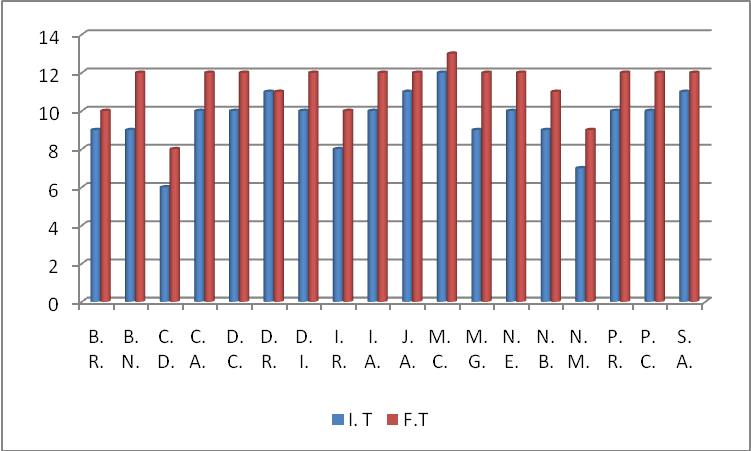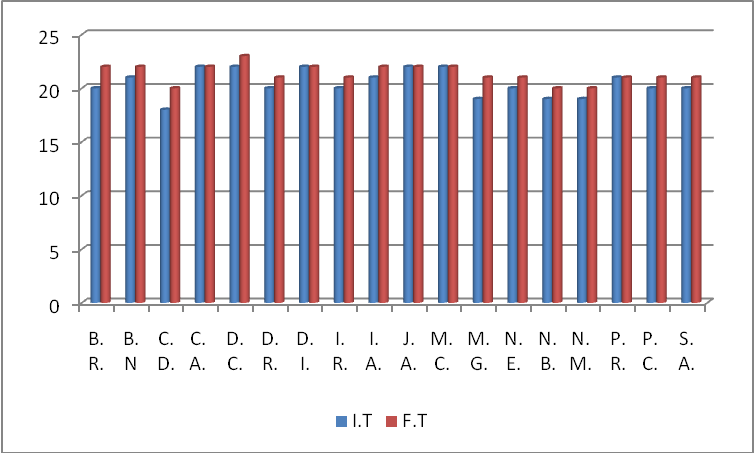Abstract
Motor skills are indispensable components of human physical activity, providing the possibility of specific efforts and, harnessing the functional potential of the body. Motor skills naturally develop to a certain level, depending on many factors, and are perfectible through practice. We believe that medium pupils’ motricity development is of paramount importance because it favourably influences the major functional indices and their volitional qualities. At the same time, it has an important role in proper and harmonious physical development, contributing to healthy growth. After puberty, which is characterized by significant and rapid somato-functional and psychomotor changes, there follows the stage of growth and development called the post-pubertal period, which is characterized by a slower rate of development and growth. The bone structure during this period is similar to that of the adult. Muscle mass also increases by 44.2% for girls. Body weight increases for both girls and boys. As children increase in age, they change as a result of growth and development processes which are subject to the laws of growth and the developmental stages. Growth refers to the quantitative aspect, whereas development is more qualitative. The two processes cannot be separated, because they are interconnected. Biological development consists of growth and physical maturity processes, changes of the internal biochemistry, and quantitative and qualitative alterations of the higher nervous activity.
Keywords: Motricitypupilsstrengthspeedresistance
Introduction
The prevailing type of activity during the pubertal period is represented by school training under the conditions of motivation diversity, personality development, aptitude, and biomotor potential enforcement. The pre-pubertal stage (from 10 to 12) is characterized by an acceleration and intensification of an increasingly higher rate of growth (especially in terms of stature), along with a significant development of secondary sexual characteristics (development of the gonads, the appearance of underarm and pubic hair). Girls go into this phase exhibiting a sudden growth spurt, gaining 22 cm in height on average (Lupu, 2010). With boys, the growth spurt may start later, between 12 and 16, and it is more prominent.
Growth is sometimes impetuous and may be accompanied by fatigue, headaches, or irritability. The child’s general conduct varies from vivacity, childishness, and exuberance to fatigue, apathy, and laziness. At the same time, the child’s conduct may be influenced by conflicting states of mind, which can focus on the effects of such moments of laziness which, in their turn, can generate family and school admonitions, although a complex emotional state occurs most of the time.
Problem Statement
The human body is ‘a hypercomplex, integrative system, which brings together devices and systems with distinct functions, consequently expressing the unity between the mental and somatic sphere, and implicitly the adjustment to external conditions’ according to Ružbarská, 2016.
Children’s changes by age are a result of growth and development processes that are subject to the laws of growth and the various development stages. ‘Growth refers to the quantitative aspect, whereas development - to the qualitative one’ according to Gheorghe, 2008. The two processes cannot be separated, because they are interconnected. Adolescence marks the transition from childhood to maturity and integration into adult society
Research Questions
-
Is there a segmental action as the child develops motor skills?
-
Is there a segmental action?
Purpose of the Study
The purpose of the paper is to present a study that aimed to optimize physical education lessons in regards to the development of schoolchildren’s motor skills.
Research Methods
After a review of the literature, we observed the development of schoolchildren. We then used an experimental method to apply specific physical education methods to see if they improved certain indices of moter skills. We recorded, compared, and interpreted the obtained results. Common statistical indicators were used, such as the mean.
The study was conducted on 16 fifth-grade students from General School number 190 from Bucharest. The initial test was done at the beginning of the first semester of the 2015-2016 school year, and the final test at the end of the second semester.
The students involved in the experiment participated in the Physical Education classes, respecting the requirements of the national curriculum for this discipline.
The following tests (according to the data shown in table
Findings
Motricity is a means of education closely connected with the intellectual and emotional sides of the individual’, according to Teodorescu, 2012.
The results obtained by assessing the muscular force of the arm in conformity with the secondary education National Assessment System present an average of 11 repetitions corresponding to a 9.72 grade. At the initial testing (IT) 10 repetitions were observed, and at the final testing (FT), 11. Thus, we observed an improvement in the number of repetitions by one push-up.

The results obtained by assessing the muscular force of the back from a face-down position in conformity with the secondary education National Assessment System present an average of 21 repetitions corresponding to a 10 grade.

Compared with the data from the secondary education National Assessment System (2002) for the secondary selection, the evaluation of the 800m sample running resistance yielded an average value of 9.27. We recorded a time of 3.32 minutes at the initial testing (IT) and 3.26 minutes at the final testing (FT). Thus, we can observe an improvement in the running time by 6 seconds.
The evaluation of the 50m sprint yielded an average value of 8.48. At the initial testing the running time was of 8.61 seconds, while at the final testing was of 8.31 seconds. We can observe an improvement in the running time by half a second.
The reaction speed, the frequency, and the movement speed were all improved. The execution speed increased more in the cases of little school pupils.
After having finished the evaluation of the participants in the study group, there emerged the following findings: average values are sensitively equal; every student was able to improve his/her results in between the initial evaluation and the final evaluation. Such types of info can be also found in Cristuta and Rata`s (2014) article.
Conclusion
Motricity is a means of education closely connected with the intellectual and emotional aspects of the individual. Middle schoolchildren’s biological development consists of growth and physical maturity processes, changes in internal biochemistry, and quantitative and qualitative alterations of higher nervous activity. Similar data can be read in Lupu`s (2011) article.The purpose of the study presented in this paper was to optimize physical education lessons in regards to development of the schoolchildren’s motor skills.
Analyzing all the data we could notice the following:
For speed running: N.M didn`t evolve at all; there was a 0.1 s improvement for M.C.; with 0.2s for M.G, N.B, P.C, S.A; with 0,3s for I.R, P.R; with 0,4s B.R, B.N, C.A, D.R, D.I, I.A, J.A; with 0,5s for C.D, D.C, N.E.
For endurance running the improved values varied between 0.13s – 0.68s; except for P.C, P.R and M.G who did not score any progress.
Related to the test for the force development of the arms muscles, D.R. registered no evolution, while B.R, J.A, M.C, S.A. improved their result by one more repetition; C.D, C.A, D.C, D.I, I.R, I.A, N.E, N.B, N.M, P.R, P.C. – with a second reiteration; B.N, M.G with three more repetitions.
For the test for force development in the back muscles C.A, D.I, J.A, M.C, P.R, P.C, S.A managed no improvement; B.R, J.A, M.C, S.A improved their score by one reiteration; B.R, C.D, M.G. – by two repetitions.
References
- Cristuță, A. M., & Rață, G. (2014). Study regarding the manifestation of psycho-motor skills in primary school children, Gymnasium, Scientific Journal of Education, Sports and Health, XV(2).
- Mate, S. (2002). Theory of sport. Publishing F.E.S.T. Bucharest. p. 21-46.
- Gheorghe, I. G. (2008). Theory of motor activities. Romania Foundation for Tomorrow. Bucharest. p. 59.
- Lupu, E. (2010). The Role of Motric Activities in the Psycho-motric Development of Preschool Children – Future Pupils. International Conference on Education and Educational Psychology (ICEEPSY).
- Ružbarská, I. (2016). Physical fitness of primary school children in the reflection of different levels of gross motor coordination. Acta Gymnica vol. 46. no. 4184–192.
- Teodorescu, S. (2012). Theory of physical education and sport. Romania Foundation for Tomorrow. Bucharest. p.72.
- Tobolcea, I., & Dumitriu, C. (2010). The importance of psychomotricity in the apparition and development of language in children, Ovidius University Annals, Series Physical Education and Sport / Science, Movement and Health, 10(2).
- Tudor V. (1999). Conditional capacity, coordinative and intermediate.. Publishing R.A Bucharest. p. 67.
Copyright information

This work is licensed under a Creative Commons Attribution-NonCommercial-NoDerivatives 4.0 International License.
About this article
Publication Date
14 September 2017
Article Doi
eBook ISBN
978-1-80296-029-7
Publisher
Future Academy
Volume
30
Print ISBN (optional)
-
Edition Number
1st Edition
Pages
1-376
Subjects
Health, public health, preventive healthcare, preventive care, preventive medicine
Cite this article as:
Maria, B. I., Anemari, T. S., & Cristian, C. G. (2017). The Importance Of Motricity Development Of Schoolchildren. In Z. Bekirogullari, M. Y. Minas, & R. X. Thambusamy (Eds.), Health and Health Psychology - icH&Hpsy 2017, vol 30. European Proceedings of Social and Behavioural Sciences (pp. 358-363). Future Academy. https://doi.org/10.15405/epsbs.2017.09.35

